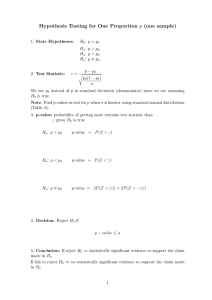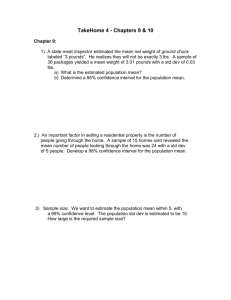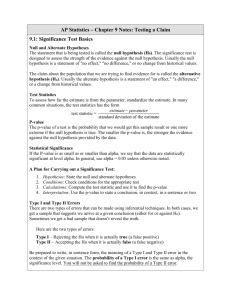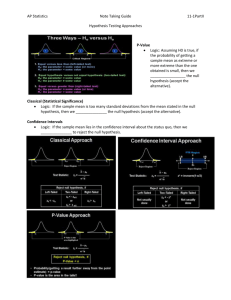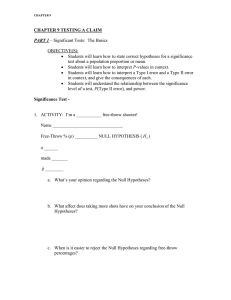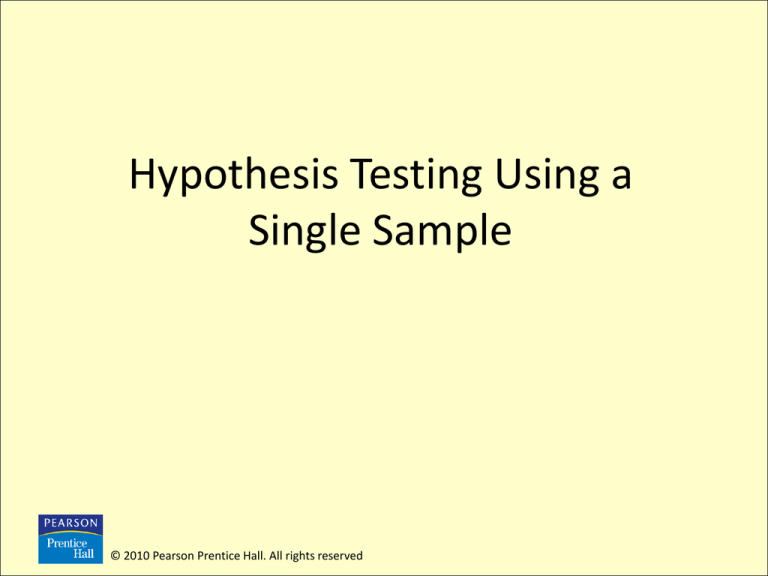
Hypothesis Testing Using a
Single Sample
© 2010 Pearson Prentice Hall. All rights reserved
Part II: Proportions
Recall:
•
The best point estimate of p, the proportion
of the population with a certain
characteristic, is given by
x
pˆ
n
where x is the number of individuals in the
sample with the specified characteristic and
n is the sample size.
10-3
Recall:
•
The sampling distribution of pˆ is approximately
normal, with mean pˆ p and standard deviation
p(1 p)
pˆ
n
following requirements are satisfied:
provided that the
1. The sample is a simple random sample.
2. np(1-p)
≥ 10.
3. The sampled values are independent of each
other.
10-4
Testing Hypotheses Regarding a Population
Proportion, p
To test hypotheses regarding the population
proportion, we can use the steps that follow,
provided that:
1. The sample is obtained by simple random
sampling.
2. np0(1-p0) ≥ 10.
3. The sampled values are independent of each
other.
10-5
Step 1: Determine the null and alternative
hypotheses. The hypotheses can be
structured in one of three ways:
10-6
Step 2: Select a level of significance, , based
on the seriousness of making a
Type I error.
10-7
Step 3: Compute the test statistic
pˆ p0
z0
p0 (1 p0 )
n
Note: We use p0 in computing the standard
ˆ . This is because, when we
error rather than p
test ahypothesis, the null hypothesis is always
assumed true.
10-8
P-Value Approach
Step 4: Use Table V to estimate the P-value.
10-9
P-Value Approach
Two-Tailed
10-10
P-Value Approach
Left-Tailed
10-11
P-Value Approach
Right-Tailed
10-12
P-Value Approach
Step 5: If the P-value < , reject the null
hypothesis.
If the P-value ≥ α, fail to reject the null
hypothesis
10-13
Step 6: State the conclusion in the
context of the problem.
10-14
Parallel Example 1: Testing a Hypothesis about a
Population Proportion: Large Sample Size
In 1997, 46% of Americans said they did not trust the
media “when it comes to reporting the news fully,
accurately and fairly”. In a 2007 poll of 1010 adults
nationwide, 525 stated they did not trust the media. At
the =0.05 level of significance, is there evidence to
support the claim that the percentage of Americans that
do not trust the media to report fully and accurately has
increased since 1997?
Source: Gallup Poll
10-15
Solution
We want to know if p>0.46. First, we must verify the
requirements to perform the hypothesis test:
1. This is a simple random sample.
2. np0(1-p0)=1010(0.46)(1-0.46)=250.8>10
3. Since the sample size is less than 5% of the
population size, the assumption of independence is
met.
10-16
Solution
Step 1: H0: p=0.46
versus
H1: p>0.46
Step 2: The level of significance is =0.05.
525
Step 3: The sample proportion is pˆ
0.52 .
1010
The test statistic is then
z0
10-17
0.52 0.46
3.83
0.46(1 0.46)
1010
Solution: P-Value Approach
Step 4: Since this is a right-tailed test, the Pvalue is the area under the standard
normal distribution to the right of the
test statistic z0=3.83. That is, P-value =
P(Z > 3.83)≈0.
Step 5: Since the P-value is less than the level of
significance, we reject the null
hypothesis.
10-18
Solution
Step 6: There is sufficient evidence at the
=0.05 level of significance to conclude
that the percentage of Americans that do
not trust the media to report fully and
accurately has increased since 1997.
10-19


